Bruce Sterling, who these days mostly lives in Belgrade, Serbia, with his wife Jasmina Testanovic, is in the U. S. for a month or more tour of lecture and conference gigs. Bruce and Jasmina travel a lot together; fittingly they were married near the LAX airport in LA.
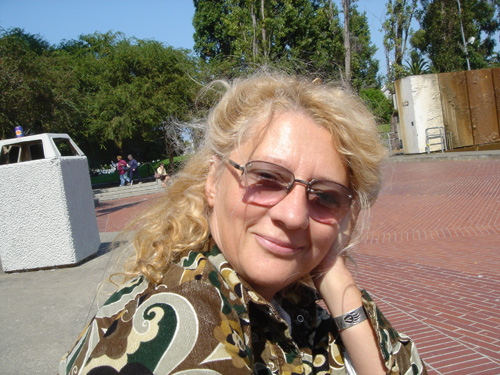
The two of them spent last night at our house, and today they went up to SF for a futurist consulting gig he had at the Global Business Network (GBN) and for a talk “Design and Futurism” that he gave at the California College of the Arts (CCA). I came along and spent the day with them, catching the train back home to San Jose — which is what I’m doing as I write these notes on the laptop that I lugged around in my backpack all day.
Jasmina loves the Internet, everywhere we went, she’d say, “Do you think they have free wireless here?” It got to be a joke over the day; I started saying it all the time.
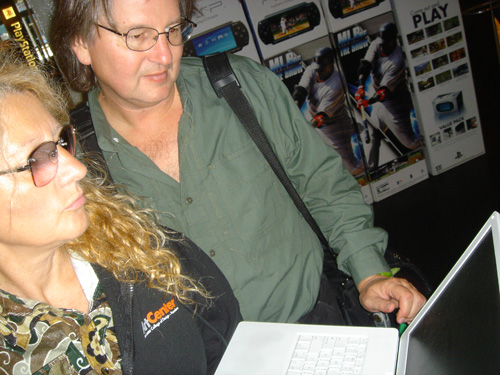
At one point she was checking her blog for comments in the SONY demo store inside the Metreon at Yerba Buena gardens, standing there, Power Book in midair. She worries about pugnacious right-wing Serbians posting comments on her blog; she feels she has to immediately respond, and spends a certain amount of energy on these flame-war comment threads. I’m fortunate not to have many comments like that on my blog; in part it’s because I mostly stay away from discussing politics, preferring to get into more esoteric stuff that’s less frequently discussed.
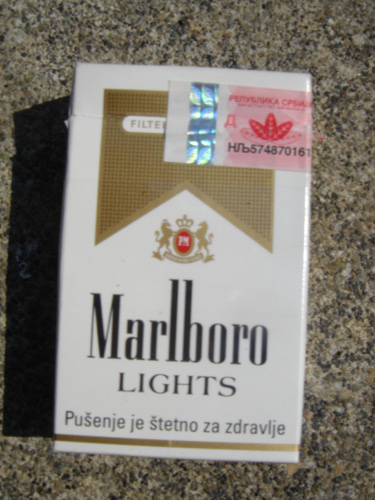
Bruce was nice to me all day; he was happy to have me there helping them find their way around SF, and to be sharing the experiences. He said it was like having a body guard. I’m kind of an older brother figure to him — eight years difference in our age. In the past I’ve sometimes envied his perhaps greater worldly success in the writing profession. But really, I can be big enough to let go of my crazy skulking resentments — at least for a little while, now and then.
Even now, I’m still grateful to him for welcoming me into the cyberpunk fold, back in early 1980s, when I was an isolated nut writer in Lynchburg, Virginia.
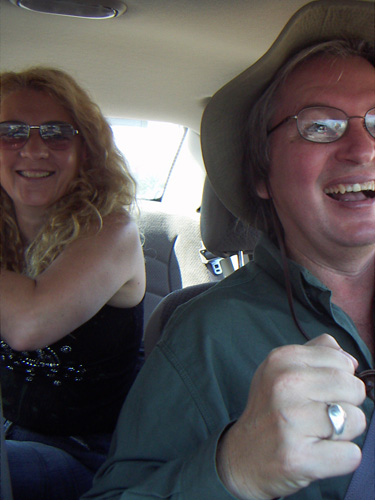
In the car on the drive up we had a good talk about this story “Hormiga Canyon” that we’re thinking of writing; it would involve giant ants, which theme is an SF power-chord long dear to my heart. We’ve done three stories together before, all were good, though the most recent collaboration was a little hard. When we communicate by email rather than in person, Bruce can get under my skin. But now that we had this good day of face-to-face contact it’ll be, I think, easier to work with him again. When we meet in person I can see his vulnerable, touching, and endearing human qualities; and, I assume, vice-versa. He does know a lot about writing stories, and it’s not a bad idea for me to listen to him.
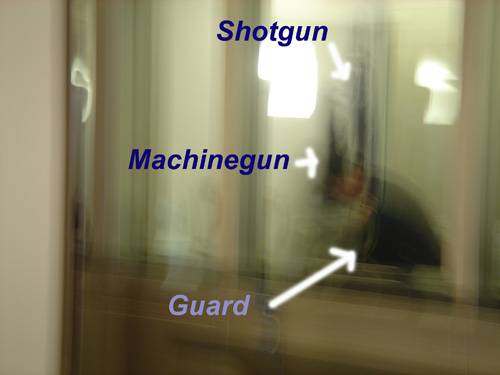
The whole day was fun, just hanging around, letting events unfurl at their own pace. Turns out the Global Business Netowork has their offices in a building near the ferry end of Market Street and the building happens to be a Federal Reserve Bank. At first I didn’t get what that meant. But the security cop in the entrance hall was behind bullet-proof glass, mounted next to him on the wall were a submachine gun and a large caliber shotgun, and once someone came down from GBN to escort us in, we had to go through airport metal detectors to get inside. After Bruce’s gig we went down to the basement and managed to find a place to peer into a room where four or five employees were using machines to process and package hundreds of millions of dollars in paper currency. Running bills through a hulking hi-tech counterfeit detector, physically washing bunches of bills, packaging them in plastic shrink wrap, piling the wrapped bricks onto heavy carts. I tried to take surreptitious pictures, but I was uneasy about them seeing my camera and possibly scolding me, and I blew the shots.
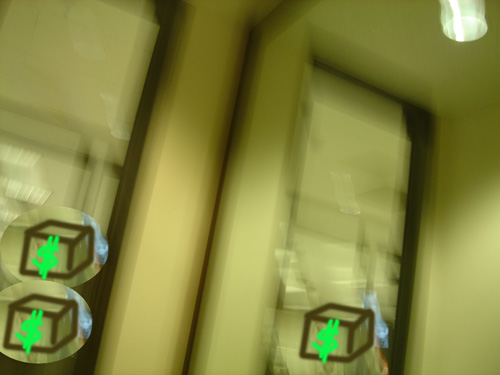
We walked up Market Street to the MOMA, then back to where we’d garaged the car at the Embarcadero. It was a fine day, with interesting foot traffic. We saw a homeless guy wearing pajama pants decorated with Happy Face men wearing Uncle Sam hats. Bruce figured it was his considered mode of self-expession.
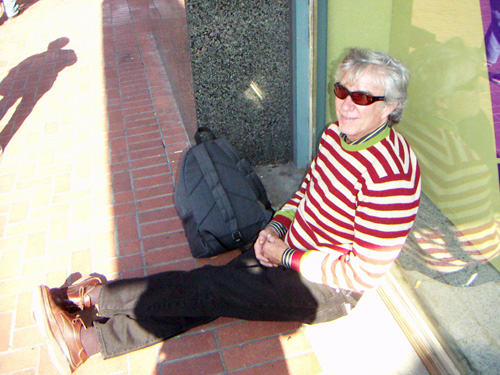
We drove to California College of the Arts early and hung in their caf�; its off the beaten track in an industrial zone near China Basin, 3rd St., and the stadium parking lots. Bruce wrote out a lot of his speech in advance; he say she talks at 100 words a minute, so 6,000 words fills an hour. When not typing, he explained Web 2.0 to me. It’s not about a new technology so much as it’s about collaborative use of active web pages that use programming tools like Ajax or Ruby on Rails (new since I retired from teaching CS).

The Flickr picture site is a good example. Social networking. Getting the users to do the work. They can explicitly tag content-topics that they notice in pictures or videos they look at, and if you track their click stream you can enhance, say, an image’s “dogginess” if users who recently looked at a dog-tagged item look at the image. So the info in the explicit tags diffuses out via the click streams.
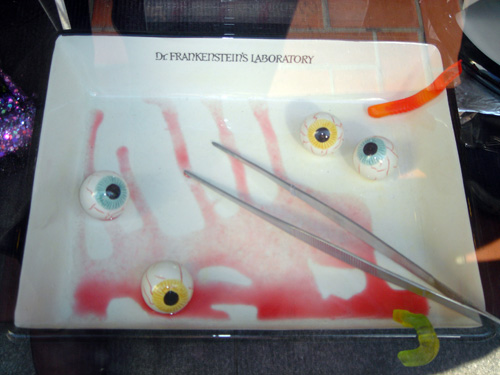
Bruce’s talk was on “Design and Futurism,” where he meant “futurism” not in the sense of the early 20th C art movement, but in the sense of the profession of consulting with businesses about their futures — he remarked that generally, the businesses who actually call in futurists are the ones that are in considerable danger of soon falling under the karmic hammer. You don’t call the doctor unless you’re sick.
He explained a popular “four-scenarios” form of futurism; the idea is to divide up the space of possible futures along two perpendicular axes; he said usually these axes correspond to the fear vs. the greed of the business that calls in a futurist. And you form some employees into four teams who are tasked to describe a scenario that fits one of the four possible quadrants of the possibility space (++, -+, –, and +-). He remarked that in a successful futurist consultation you are like a psychiatrist who is empowering people to say what they already know about their situation but have been afraid to articulate. It’s usually the middle managers who are the most emotionally invested in continuing business as usual.
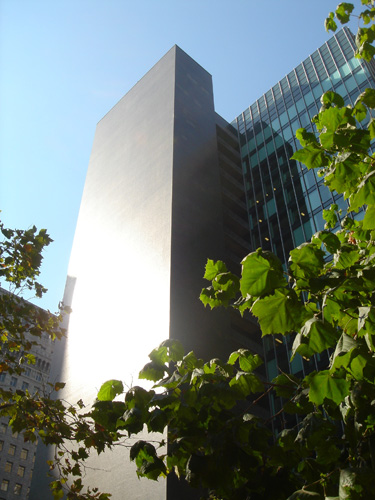
He segued into his concluding rap from his futurist book Tomorrow Today, about how futurism is something we do in the present, and that it in fact bears little connection to the real future. We live in time and our futures are unknowable. As Updike once wrote, time is our medium, not some mistaken invader. It’s the air we fly in, the water we swim in, the earth we walk upon, the fire in our veins. All the people of the Middle Ages are dead, all their craft techniques are obsolete. Same for the nineteenth century, matter of fact, and, before long, for us. It’s the way things are, there’s no need to grieve. Futurism is just a game we play in the present. A pastime.

Nevertheless, the game matters. We owe it to our descendants to allow them as wide a range of options as we’ve enjoyed. We should think in terms of making sustainability seem modern and fun instead of finger-wagging and dull. And that one way to do this is, as he suggests in his MIT mini-tome Shaping Things, to individualize objects, possibly with what he calls arphids. “Arphid” is Bruce’s word for RFIDs or “radio frequency ID tags.” I heard him talking about arphids when he visited last year, and I ended up repurposing or one-upping or aping his notion for my ubiquitous position-aware dog-smart quantum-computing-molecular-nanomachine entanglement-linked “orphids” in Postsingular. He uses the word “spime” to refer to an enhanced object that carries with it an individualized link to online info about how it was made, where it’s been, user-evaluations, online instructions for regular and hackeristic use, how the object might be repurposed, and more. Every object is now part of the Web. Worn-out or discarded-but-still-good things might become “smart garbage.”
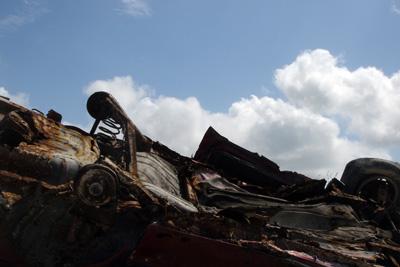
Most of us have things in our basements or closets that we’d be, in principle, willing to give away. I discussed this idea a bit in the “Big Pig Posse” chapter of Postsingular. You’d give them or at least lend them to a friend or relative for free. Skis, power saws, clothes, old computers, old clothes, surfboard. One catch here is that you wouldn’t necessarily give or lend these things to a stranger. Not if, say, the stranger were simply planning to sell them for cash on eBay. Not if the stranger were possibly going to ruin your nail-gun by failing to oil it, and would then return it to you broken. But maybe, at some point you could learn not to care. If, after all, everyone could get junk for free from their neighbor’s attics, there might not actually be much traffic on eBay. And maybe you could have a reliability rating that would be ruined by trashing someone’s tools — and hey, even if your rarely used tool did get trashed, so what you could borrow another one. Maybe you’d even get an improved reliability rating as a “reward” for having suffered a loss to the system.
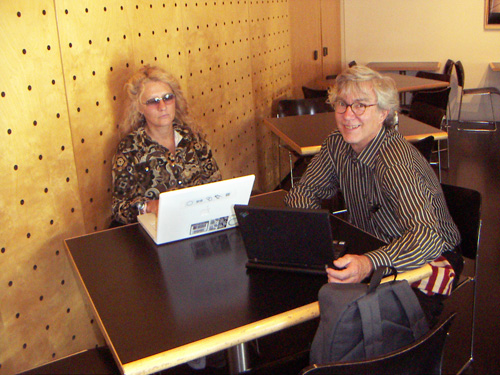
Hanging with Bruce and Jasmina, it was kind of fun the way there was no social stigma about breaking out the laptop; like being a stoner among other heavy users.
After his talk we had a nice dinner at a place just a block away from the Cal Train station with a couple of the CCA faculty, Brenda Laurel of VR fame and the graphic designer called Stuart McKee — I think he just handed over the leadership of the CCA grad design program to Brenda. The waitress was odd-looking yet cute, very animated, almost like a Dr. Seuss character. She told Stuart she’d just moved to San Francisco. Everyone very friendly. I had to leave early to catch the last train down to the South Bay, and got my food to go.
Nice to be out of my hermit’s cave, out in the marketplace today.








